Ecological Assessment and SWOT–AHP Integration for Sustainable Management of a Mediterranean Freshwater Lake
Abstract
1. Introduction
2. Materials and Methods
2.1. Study Area
2.2. Data Sources
2.3. Ecological Quality Assessment
2.4. The SWOT–AHP Method
- Goal level—Prioritizing effective, sustainable management strategies for Lake Paralimni.
- Criteria level—SWOT categories (strengths, weaknesses, opportunities, threats).
- Alternative level—Proposed strategies for conservation and lake management.
- SWOT categories were ranked by importance (e.g., threats > weaknesses > strengths > opportunities),
- Factors within each SWOT group were weighted (e.g., Water Level Fluctuations, Climate-induced Droughts),
- Management strategies were evaluated and prioritized across three AHP criteria: environmental impact, feasibility, and urgency.
3. Results
3.1. Field Survey
3.2. Ecological Quality
3.3. SWOT–AHP Analysis
4. Discussion
4.1. Fish Fauna Composition and Ecological Insights
4.2. Ecological Quality
4.3. The SWOT–AHP Analysis in Fish and Water Resources Management
4.4. Management Priorities and Conservation Strategies
5. Conclusions
Author Contributions
Funding
Institutional Review Board Statement
Data Availability Statement
Acknowledgments
Conflicts of Interest
References
- Beklioglu, M.; Romo, S.; Kagalou, I.; Quintana, X.; Bécares, E. State of the art in the functioning of shallow Mediterranean lakes: Workshop conclusions. Hydrobiologia 2007, 584, 317–326. [Google Scholar] [CrossRef]
- Lionello, P.; Abrantes, F.; Gacic, M.; Planton, S.; Trigo, R.; Ulbrich, U. The climate of the Mediterranean region: Research progress and climate change impacts. Reg. Environ. Change 2014, 14, 1679–1684. [Google Scholar] [CrossRef]
- Lynch, A.J.; Cooke, S.J.; Arthington, A.H.; Baigun, C.; Bossenbroek, L.; Dickens, C.; Harrison, I.; Kimirei, I.; Langhans, S.D.; Murchie, K.J.; et al. People need freshwater biodiversity. Wiley Interdiscip. Rev. Water 2023, 10, e1633. [Google Scholar] [CrossRef]
- Grizzetti, B.; Lanzanova, D.; Liquete, C.; Reynaud, A.; Cardoso, A.C. Assessing water ecosystem services for water resource management. Environ. Sci. Policy 2016, 61, 194–203. [Google Scholar] [CrossRef]
- Heino, J.; Alahuhta, J.; Bini, L.M.; Cai, Y.; Heiskanen, A.S.; Hellsten, S.; Kortelainen, P.; Kotamäki, N.; Tolonen, K.T.; Vihervaara, P.; et al. Lakes in the era of global change: Moving beyond single-lake thinking in maintaining biodiversity and ecosystem services. Biol. Rev. 2021, 96, 89–106. [Google Scholar] [CrossRef]
- Reid, A.J.; Carlson, A.K.; Creed, I.F.; Eliason, E.J.; Gell, P.A.; Johnson, P.T.J.; Kidd, K.A.; MacCormack, T.J.; Olden, J.D.; Ormerod, S.J.; et al. Emerging threats and persistent conservation challenges for freshwater biodiversity. Biol. Rev. 2019, 94, 849–873. [Google Scholar] [CrossRef]
- Cantonati, M.; Poikane, S.; Pringle, C.M.; Stevens, L.E.; Turak, E.; Heino, J.; Richardson, J.S.; Bolpagni, R.; Borrini, A.; Cid, N.; et al. Characteristics, main impacts, and stewardship of natural and artificial freshwater environments: Consequences for biodiversity conservation. Water 2020, 12, 260. [Google Scholar] [CrossRef]
- Soares, L.M.V.; Thouillot, M.; Frossard, V.; Desgué-Itier, O.; Barouillet, C.; Baulaz, Y.; Clément, J.-C.; Domaizon, I.; Dorioz, J.-M.; Goulon, C.; et al. Expanding the European Water Framework Directive indicators to address long-term climate change impacts on lakes using mechanistic lake models. Ecol. Indic. 2025, 172, 113220. [Google Scholar] [CrossRef]
- Dudgeon, D.; Arthington, A.H.; Gessner, M.O.; Kawabata, Z.I.; Knowler, D.J.; Lévêque, C.; Naiman, R.J.; Prieur-Richard, A.-H.; Soto, D.; Stiassny, M.L.J.; et al. Freshwater biodiversity: Importance, threats, status and conservation challenges. Biol. Rev. 2006, 81, 163–182. [Google Scholar] [CrossRef]
- Winfield, I.J.; Baigún, C.; Balykin, P.A.; Becker, B.; Chen, Y.; Filipe, A.F.; Gerasimov, Y.V.; Godinho, A.L.; Hughes, R.M.; Koehn, J.D.; et al. International perspectives on the effects of climate change on inland fisheries. Fisheries 2016, 41, 399–405. [Google Scholar] [CrossRef]
- Comte, L.; Buisson, L.; Daufresne, M.; Grenouillet, G. Climate-induced changes in the distribution of freshwater fish: Observed and predicted trends. Freshw. Biol. 2013, 58, 625–639. [Google Scholar] [CrossRef]
- Comte, L.; Olden, J.D. Climatic vulnerability of the world’s freshwater and marine fishes. Nat. Clim. Change 2017, 7, 718–722. [Google Scholar] [CrossRef]
- Holmlund, C.M.; Hammer, M. Ecosystem services generated by fish populations. Ecol. Econ. 1999, 29, 253–268. [Google Scholar] [CrossRef]
- Makanda, K.; Nzama, S.; Kanyerere, T. Assessing the role of water resources protection practice for sustainable water resources management: A review. Water 2022, 14, 3153. [Google Scholar] [CrossRef]
- Ustaoglu, E.; Williams, B. Determinants of urban expansion and agricultural land conversion in 25 EU countries. Environ. Manag. 2017, 60, 717–746. [Google Scholar] [CrossRef]
- Yavuz, F.; Baycan, T. Application of combined Analytic Hierarchy Process (AHP) and SWOT for integrated watershed management. Int. J. Anal. Hierarchy Process 2014, 6, 1. [Google Scholar]
- Thungngern, J.; Wijitkosum, S.; Sriburi, T.; Sukhsri, C. A review of the analytical hierarchy process (AHP): An approach to water resource management in Thailand. Appl. Environ. Res. 2015, 37, 13–32. [Google Scholar] [CrossRef]
- Cacal, J.C.; Taboada, E.B.; Mehboob, M.S. Strategic implementation of integrated water resource management in selected areas of Palawan: SWOT-AHP method. Sustainability 2023, 15, 2922. [Google Scholar] [CrossRef]
- European Parliament and Council. Directive 2000/60/EC Establishing a Framework for Community Action in the Field of Water Policy; Official Journal of the European Communities L327:1–73; European Parliament and Council: Strasbourg, France, 2000. [Google Scholar]
- Tolonen, K.T.; Hämäläinen, H.; Lensu, A.; Meriläinen, J.J.; Palomäki, A.; Karjalainen, J. The relevance of ecological status to ecosystem functions and services in a large boreal lake. J. Appl. Ecol. 2014, 51, 560–571. [Google Scholar] [CrossRef]
- Ho, L.T.; Goethals, P.L. Opportunities and challenges for the sustainability of lakes and reservoirs in relation to the Sustainable Development Goals (SDGs). Water 2019, 11, 1462. [Google Scholar] [CrossRef]
- Dean, A.J. The Lake Copais, Boeotia, Greece: Its drainage and development. (Includes appendix). J. Inst. Civ. Eng. 1937, 5, 287–304. [Google Scholar] [CrossRef]
- Griffiths, S.J.; Street-Perrott, F.A.; Holmes, J.A.; Leng, M.J.; Tzedakis, C. Chemical and isotopic composition of modern water bodies in the Lake Kopais Basin, central Greece: Analogues for the interpretation of the lacustrine sedimentary sequence. Sediment. Geol. 2002, 148, 79–103. [Google Scholar] [CrossRef]
- Stamou, G.; Katsiapi, M.; Moustaka-Gouni, M.; Michaloudi, E. The neglected zooplankton communities as indicators of ecological water quality of Mediterranean lakes. Limnetica 2021, 40, 359–373. [Google Scholar] [CrossRef]
- Economidis, P.S.; Dimitriou, E.; Pagoni, R.; Michaloudi, E.; Natsis, L. Introduced and translocated fish species in the inland waters of Greece. Fish. Manag. Ecol. 2000, 7, 239–250. [Google Scholar] [CrossRef]
- Vardakas, L.; Koutsikos, N.; Perdikaris, C.; Petriki, O.; Bobori, D.; Zogaris, S.; Giakoumi, S.; Fitoka, E.; Tompoulidou, M.; Tsiaoussi, V.; et al. The fish fauna in lentic ecosystems of Greece. Mediterr. Mar. Sci. 2022, 23, 223–265. [Google Scholar] [CrossRef]
- Froese, R.; Pauly, D. FishBase. World Wide Web Electronic Publication. Available online: www.fishbase.org (accessed on 2 January 2025).
- EN 14757:2005; Water Quality—Sampling of Fish with Multimesh Gillnets. European Committee for Standardization: Brussels, Belgium, 2005; 27p.
- Petriki, O.; Stergiou, K.I.; Bobori, D.C. Can fish sampling protocol (CEN, 2005) be amended for Mediterranean lakes? Fish. Manag. Ecol. 2017, 24, 146–155. [Google Scholar] [CrossRef]
- Tsiaoussi, V.; Mavromati, E.; Kemitzoglou, D. Report on the Development of the National Method for the Assessment of the Ecological Status of Natural Lakes in Greece, Using the Biological Quality Element “Phytoplankton”, 1st Revision; Greek Biotope/Wetland Centre and Special Secretariat for Waters, Ministry of Environment: Thermi, Greece, 2017. [Google Scholar]
- Ntislidou, C.; Lazaridou, M.; Tsiaoussi, V.; Bobori, D.C. A new multimetric macroinvertebrate index for the ecological assessment of Mediterranean lakes. Ecol. Indic. 2018, 93, 1020–1033. [Google Scholar] [CrossRef]
- Zervas, D.; Tsiaoussi, V.; Tsiripidis, I. HeLM: A macrophyte-based method for monitoring and assessment of Greek lakes. Environ. Monit. Assess. 2018, 190, 326. [Google Scholar] [CrossRef]
- Kagalou, I.; Leonardos, I. Typology, classification and management issues of Greek lakes: Implication of the Water Framework Directive (2000/60/EC). Environ. Monit. Assess. 2009, 150, 469–484. [Google Scholar] [CrossRef]
- Mavromati, E.; Kagalou, I.; Kemitzoglou, D.; Apostolakis, A.; Seferlis, M.; Tsiaoussi, V. Relationships among land use patterns, hydromorphological features and physicochemical parameters of surface waters: WFD lake monitoring in Greece. Environ. Process. 2018, 5 (Suppl. 1), 139–151. [Google Scholar] [CrossRef]
- European Environment Agency. Corine Land Cover; European Environment Agency: Copenhagen, Denmark, 2000. [Google Scholar]
- Petriki, O.; Lazaridou, M.; Bobori, D.C. A fish-based index for the assessment of the ecological quality of temperate lakes. Ecol. Indic. 2017, 78, 556–565. [Google Scholar] [CrossRef]
- Rowan, J.S.; Carwardine, J.; Duck, R.W.; Bragg, O.M.; Black, A.R.; Cutler, M.E.J.; Soutar, I.; Boon, P.J. Development of a technique for lake habitat survey (LHS) with applications for the European Union Water Framework Directive. Aquat. Conserv. 2006, 16, 637–657. [Google Scholar] [CrossRef]
- Moe, S.J.; Solheim, A.L.; Soszka, H.; Gołub, M.; Hutorowicz, A.; Kolada, A.; Picińska-Fałtynowicz, J.; Białokoz, W. Integrated assessment of ecological status and misclassification of lakes: The role of uncertainty and index combination rules. Ecol. Indic. 2015, 48, 605–615. [Google Scholar] [CrossRef]
- Lee, B.K.; Kang, K.H.; Lee, Y.H. Decomposition heuristic to minimize total cost in a multi-level supply chain network. Comput. Ind. Eng. 2008, 54, 945–959. [Google Scholar] [CrossRef]
- Leigh, D. SWOT analysis. In Handbook of Improving Performance in the Workplace: Volumes 1–3; Wiley: Hoboken, NJ, USA, 2009; pp. 115–140. [Google Scholar]
- Ghazinoory, S.; Abdi, M.; Azadegan-Mehr, M. SWOT methodology: A state-of-the-art review for the past, a framework for the future. J. Bus. Econ. Manag. 2011, 12, 24–48. [Google Scholar] [CrossRef]
- Banihabib, M.E.; Azarnivand, A.; Peralta, R.C. A new framework for strategic planning to stabilize a shrinking lake. Lake Reserv. Manag. 2015, 31, 31–43. [Google Scholar] [CrossRef][Green Version]
- Scolozzi, R.; Schirpke, U.; Morri, E.; D’Amato, D.; Santolini, R. Ecosystem services-based SWOT analysis of protected areas for conservation strategies. J. Environ. Manag. 2014, 146, 543–551. [Google Scholar] [CrossRef]
- Kurttila, M.; Pesonen, M.; Kangas, J.; Kajanus, M. Utilizing the analytic hierarchy process (AHP) in SWOT analysis—A hybrid method and its application to a forest-certification case. For. Policy Econ. 2000, 1, 41–52. [Google Scholar] [CrossRef]
- Rane, N.; Achari, A.; Choudhary, S. Multi-Criteria Decision-Making (MCDM) as a powerful tool for sustainable development: Effective applications of AHP, FAHP, TOPSIS, ELECTRE, and VIKOR in sustainability. Int. Res. J. Mod. Eng. Technol. Sci. 2023, 5, 2654–2670. [Google Scholar]
- Forman, E.H.; Gass, S.I. The analytic hierarchy process—An exposition. Oper. Res. 2001, 49, 469–486. [Google Scholar] [CrossRef]
- Saaty, T.L. Decision Making with the Analytic Hierarchy Process. Int. J. Serv. Sci. 2008, 1, 83–98. [Google Scholar] [CrossRef]
- Ho, W. Integrated analytic hierarchy process and its applications—A literature review. Eur. J. Oper. Res. 2008, 186, 211–228. [Google Scholar] [CrossRef]
- Cambray, J.A. Impact on indigenous species biodiversity caused by the globalisation of alien recreational freshwater fisheries. Hydrobiologia 2003, 500, 217–230. [Google Scholar] [CrossRef]
- Leprieur, F.; Brosse, S.; García-Berthou, E.; Oberdorff, T.; Olden, J.D.; Townsend, C.R. Scientific uncertainty and the assessment of risks posed by non-native freshwater fishes. Fish Fish. 2009, 10, 88–97. [Google Scholar] [CrossRef]
- Villéger, S.; Blanchet, S.; Beauchard, O.; Oberdorff, T.; Brosse, S. Homogenization patterns of the world’s freshwater fish faunas. Proc. Natl. Acad. Sci. USA 2011, 108, 18003–18008. [Google Scholar] [CrossRef]
- Petsch, D.K. Causes and consequences of biotic homogenization in freshwater ecosystems. Int. Rev. Hydrobiol. 2016, 101, 113–122. [Google Scholar] [CrossRef]
- Petriki, O.; Bobori, D.C. Compositional and functional changes within Greek (southeastern Balkans) lentic fish assemblages. Biol. Invasions 2025, 27, 90. [Google Scholar] [CrossRef]
- Feunteun, E. Management and restoration of European eel population (Anguilla anguilla): An impossible bargain. Ecol. Eng. 2002, 18, 575–591. [Google Scholar] [CrossRef]
- Bevacqua, D.; Melià, P.; Gatto, M.; De Leo, G.A. A global viability assessment of the European eel. Glob. Change Biol. 2015, 21, 3323–3335. [Google Scholar] [CrossRef]
- Copp, G.H.; Bianco, P.G.; Bogutskaya, N.G.; Eros, T.; Falka, I.; Ferreira, M.T.; Fox, M.G.; Freyhof, J.; Gozlan, R.E.; Grabowska, J.; et al. To be, or not to be, a non-native freshwater fish? J. Appl. Ichthyol. 2005, 21, 242–262. [Google Scholar] [CrossRef]
- Gozlan, R.E.; Peeler, E.J.; Longshaw, M.; St-Hilaire, S.; Feist, S.W. Effect of microbial pathogens on the diversity of aquatic populations, notably in Europe. Microbes Infect. 2006, 8, 1358–1364. [Google Scholar] [CrossRef] [PubMed]
- Gratwicke, B.; Marshall, B.E. The relationship between the exotic predators Micropterus salmoides and Serranochromis robustus and native stream fishes in Zimbabwe. J. Fish Biol. 2001, 58, 68–75. [Google Scholar] [CrossRef]
- Cucherousset, J.; Olden, J.D. Ecological impacts of non-native freshwater fishes. Fisheries 2011, 36, 215–230. [Google Scholar] [CrossRef]
- Magnuson, J.J.; Crowder, L.B.; Medvick, P.A. Temperature as an ecological resource. Am. Zool. 1979, 19, 331–343. [Google Scholar] [CrossRef]
- Winfield, I.J. Fish in the littoral zone: Ecology, threats and management. Limnologica 2004, 34, 124–131. [Google Scholar] [CrossRef]
- Jeppesen, E.; Jensen, J.P.; Jensen, C.; Faafeng, B.; Hessen, D.O.; Søndergaard, M.; Lauridsen, T.; Brettum, P.; Christoffersen, K. The impact of nutrient state and lake depth on top-down control in the pelagic zone of lakes: A study of 466 lakes from the temperate zone to the Arctic. Ecosystems 2003, 6, 313–325. [Google Scholar] [CrossRef]
- Bazzanti, M.; Seminara, M.; Baldoni, S.; Dowgiallo, M.G. Assessing hypolimnetic stress in a monomictic, eutrophic lake using profundal sediment and macrobenthic characteristics. J. Freshw. Ecol. 1998, 13, 405–412. [Google Scholar] [CrossRef]
- Moutopoulos, D.K.; Petriki, O.; Ramfos, A.; Stoumboudi, M.T.; Stergiou, K.I.; Bobori, D.C. Portraying fisheries and ecological status of a Mediterranean lake. Acta Ichthyol. Piscat. 2020, 50, 71–83. [Google Scholar] [CrossRef]
- Bakalár, T.; Pavolová, H.; Tokarčík, A. Analysis and model of river basin sustainable management by SWOT and AHP methods. Water 2021, 13, 2427. [Google Scholar] [CrossRef]
- Sharifipour, R.; Mahmodi, B. Presentation of coastal environmental management plan by using SWOT/AHP methods. J. Appl. Sci. Environ. Manag. 2012, 16, 157–163. [Google Scholar]
- Hasani, Q.; Julian, D.; Damai, A.A.; Yudha, I.G.; Diantari, R.; Yuliana, D.; Reza, M.; Caesario, R.; Putriani, R.B. Priority strategy in the development of sustainable capture fisheries in the Marine Protected Area of Kiluan Bay, Lampung, Indonesia. Aquac. Aquar. Conserv. Legis. 2024, 17, 764–774. [Google Scholar]
- Walangitan, H.D.; Rotinsulu, W.C.; Paat, F.J. Analysis of management strategies for Lake Tondano ecosystem in North Sulawesi, Indonesia using SWOT and AHP methods. Rev. Gest. Soc. Ambient. 2024, 18, 1–20. [Google Scholar] [CrossRef]
- Felice, F.D.; Petrillo, A.; Autorina, C.; Carlomusto, A. Sustainable decision-making model based on analytical hierarchy process and SWOT analysis: “S-AHP” model. In Proceedings of the International Symposium on the Analytic Hierarchy Process 2013, Kuala Lampur, Malaysia, 19–23 June 2013. [Google Scholar]
- Dokulil, M.T.; Teubner, K.; Jagsch, A.; Nickus, U.; Adrian, R.; Straile, D.; Jankowski, T.; Herzig, A.; Padisák, J. The impact of climate change on lakes in Central Europe. In The Impact of Climate Change on European Lakes; George, D.G., Ed.; Springer: Dordrecht, The Netherlands, 2010; pp. 387–409. [Google Scholar]
- Yousefi Siahkalroodi, S.; Kouchakian, H.; Mojabi, M.; Mohebi Derakhash, P.; Olad Azimi, N.; Yousefi Siahkalroodi, M. Assessment of the restoration trend of sturgeon stocks in Iranian waters of the Caspian Sea using SWOT model. Iran. J. Fish. Sci. 2025, 24, 19–38. [Google Scholar]
- Jeppesen, E.; Meerhoff, M.; Davidson, T.; Trolle, D.; Søndergaard, M.; Lauridsen, T.; Beklioglu, M.; Brucet, S.; Volta, P.; González-Bergonzoni, I.; et al. Climate change impacts on lakes: An integrated ecological perspective based on a multi-faceted approach, with special focus on shallow lakes. J. Limnol. 2014, 73, 84–107. [Google Scholar] [CrossRef]
- Jeppesen, E.; Kronvang, B.; Olesen, J.E.; Audet, J.; Søndergaard, M.; Hoffmann, C.C.; Andersen, H.E.; Lauridsen, T.L.; Liboriussen, L.; Larsen, S.E.; et al. Climate change effects on nitrogen loading from cultivated catchments in Europe: Implications for nitrogen retention, ecological state of lakes and adaptation. Hydrobiologia 2011, 663, 1–21. [Google Scholar] [CrossRef]
- Jeppesen, E.; Moss, B.; Bennion, H.; Carvalho, L.; De Meester, L.; Feuchtmayr, H.; Friberg, N.; Gessner, M.O.; Hefting, M.; Lauridsen, T.L.; et al. Chapter 5: Interaction of climate change and eutrophication. In Climate Change Impacts on Freshwater Ecosystems; Kernan, M., Battarbee, R., Moss, B., Eds.; Wiley-Blackwell: London, UK, 2010; pp. 119–146. [Google Scholar]
- Petriki, O.; Bobori, D.C. Unraveling Greek inland competitive fishing: Historical insights, angler profiles, and motivations through limited data integration in recreational fishing research. Fishes 2024, 9, 278. [Google Scholar] [CrossRef]
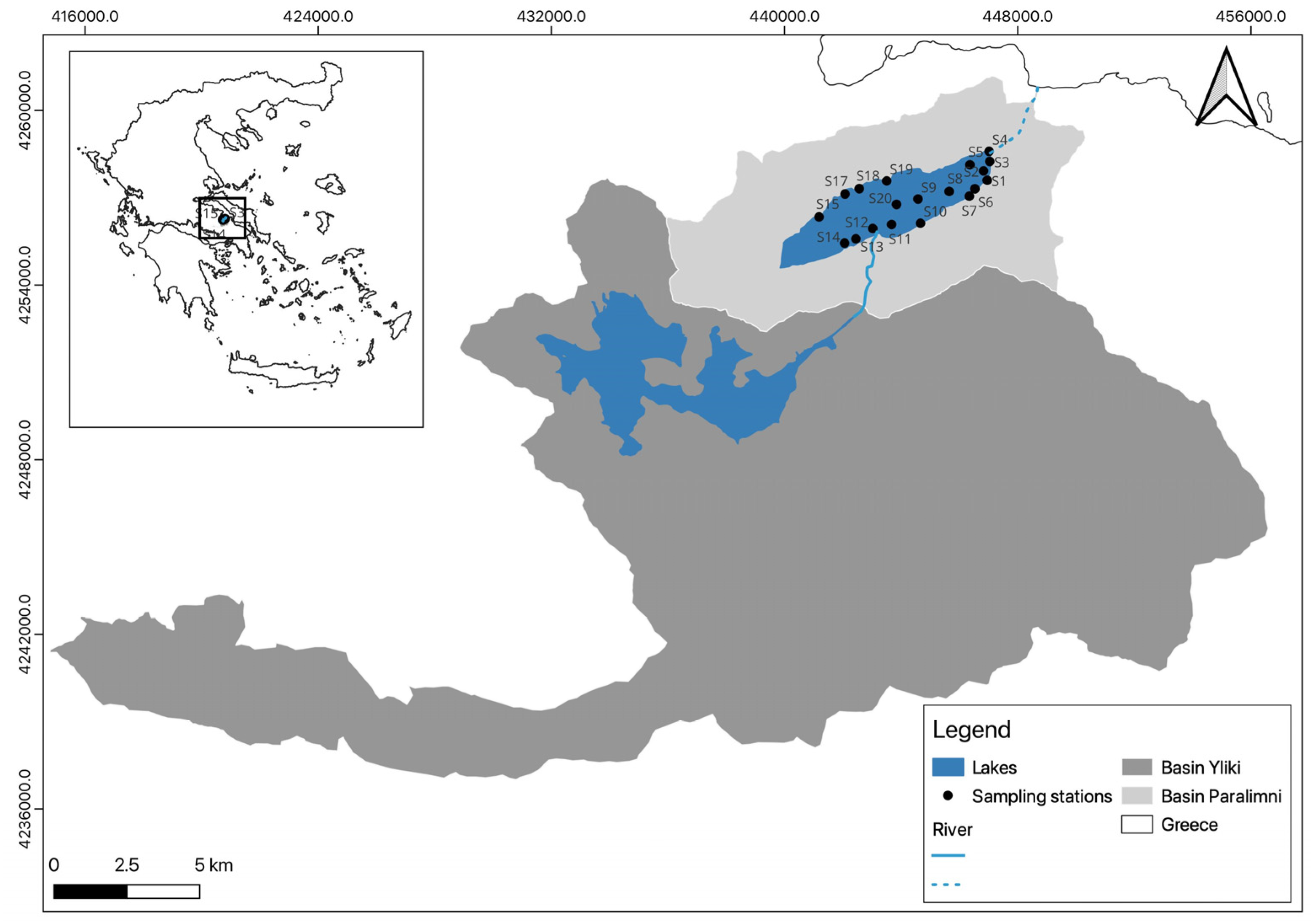

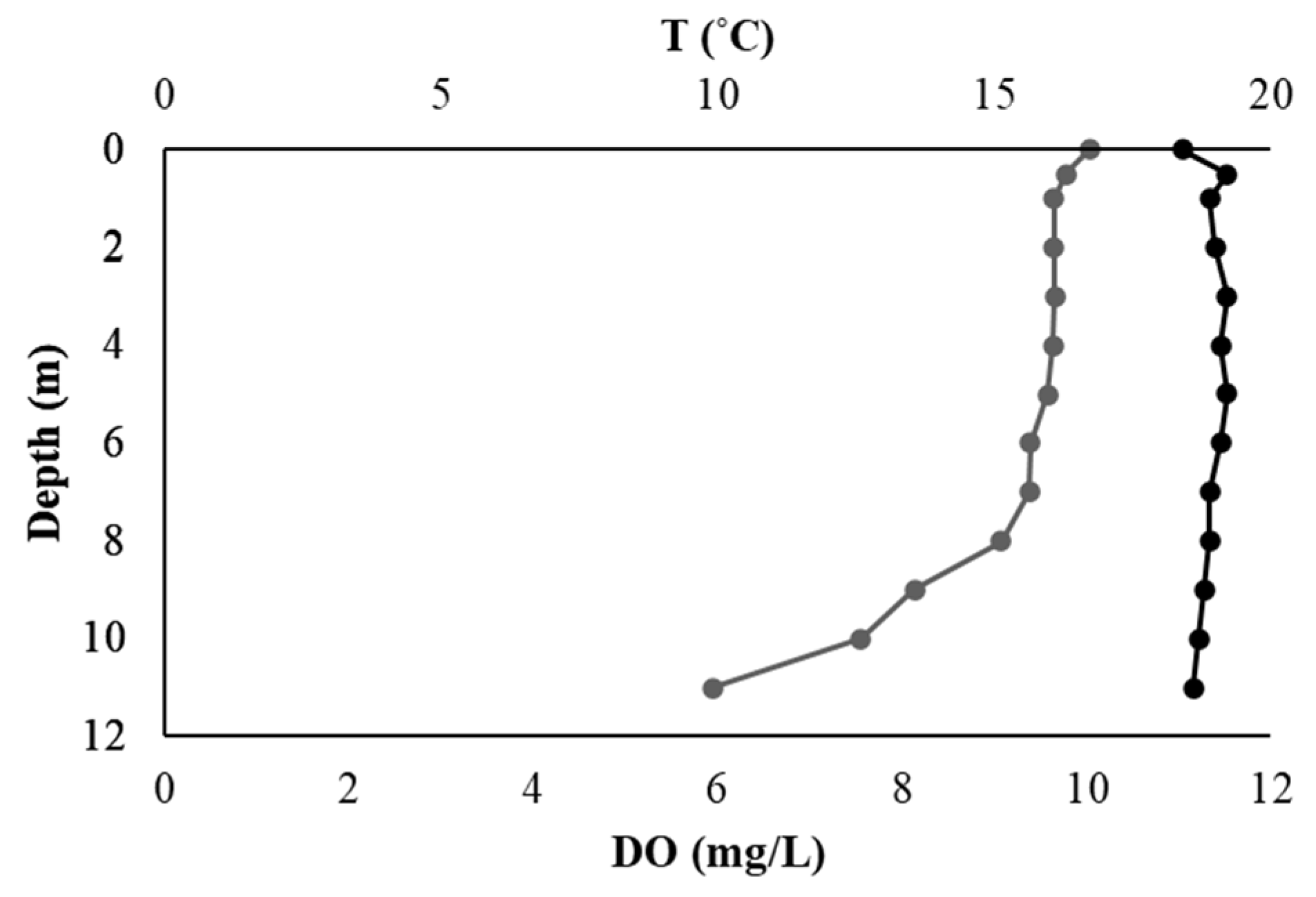
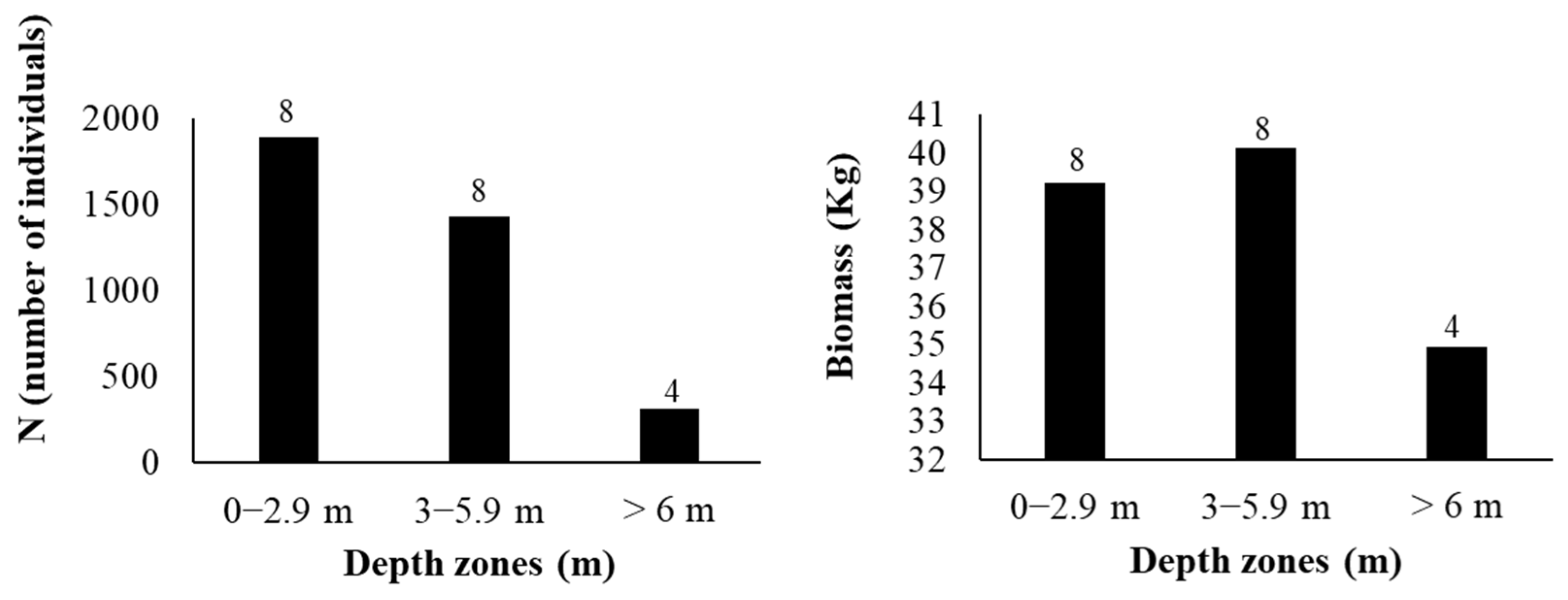
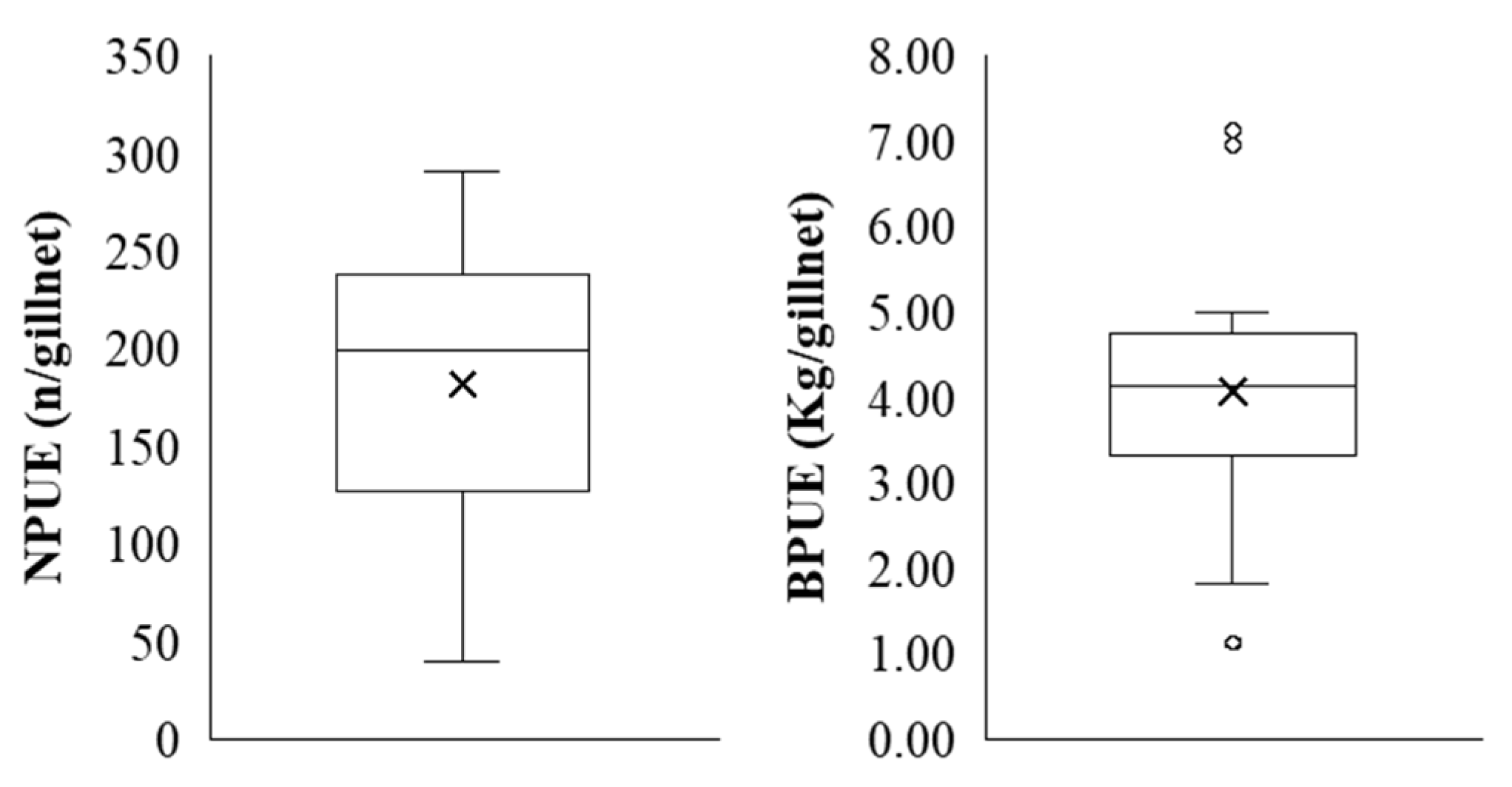
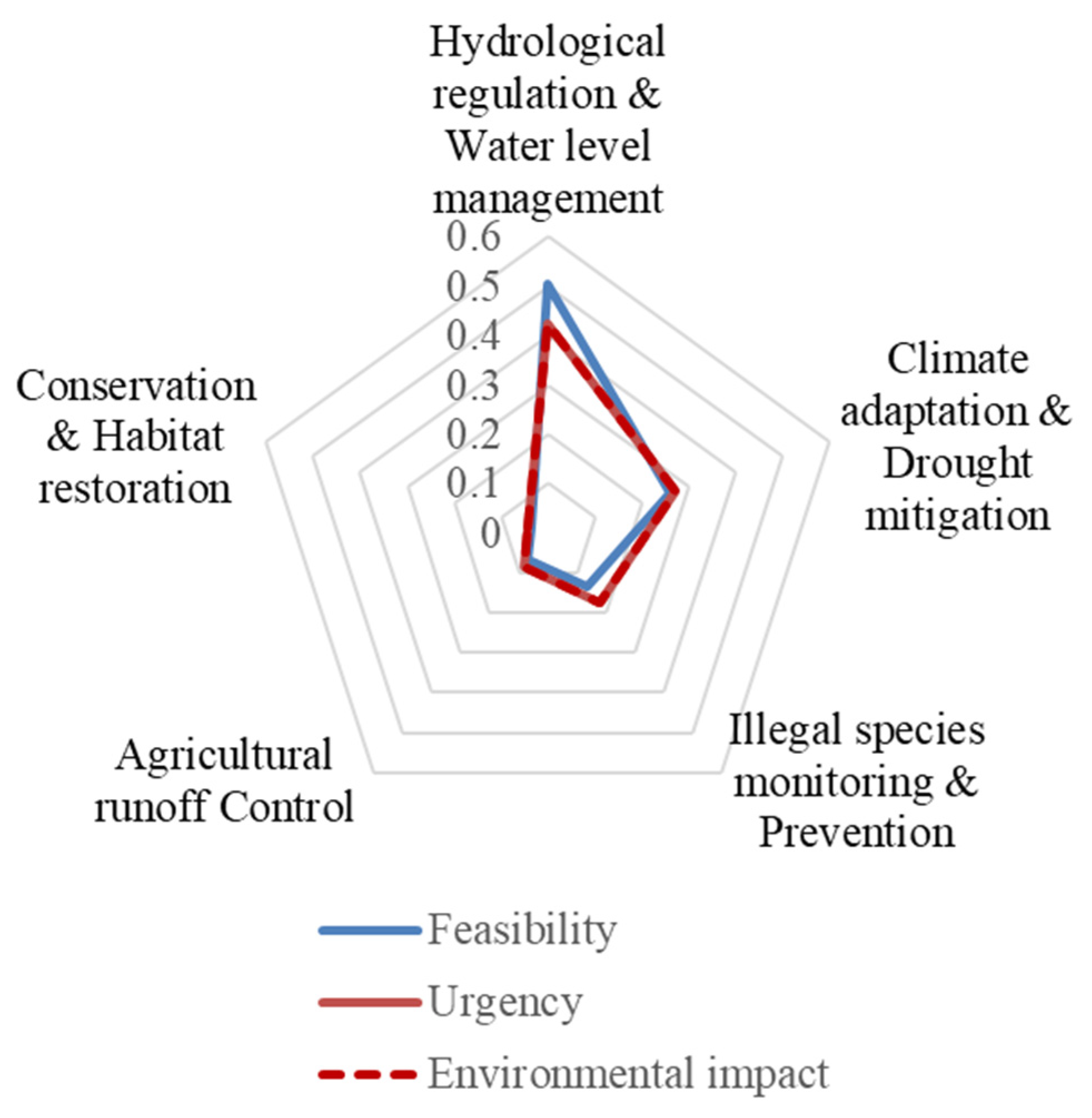
| Family | Species | Origin | IUCN Status |
|---|---|---|---|
| Anguillidae | Anguilla anguilla (Linnaeus, 1758) | N | CR |
| Cyprinidae | Cyprinus carpio Linnaeus, 1758 | N | LC |
| Luciobarbus graecus (Steindachner, 1895) | N | LC | |
| Leuciscidae | Pelasgus marathonicus (Vinciguerra, 1921) | N | NT |
| Leucos ylikiensis (Economidis, 1991) | N | EN | |
| Scardinius graecus Stephanidis, 1937 | N | EN | |
| Telestes beoticus (Stephanidis, 1939) | N | EN | |
| Siluridae | Silurus aristotelis Garman, 1890 | T | EN |
| Xenocyprididae | Ctenopharyngodon idella (Valenciennes, 1844) | A | LC |
| Hypophthalmichthys molitrix (Valenciennes, 1844) | A | NT | |
| Hypophthalmichthys nobilis (Richardson, 1845) | A | DD | |
| Total species number | 11 |
| Intensity of Importance | Definition | Explanation |
|---|---|---|
| 1 | Equal importance | Two activities contribute equally to the objective. |
| 3 | Moderate importance | Experience and judgment slightly favor one activity over another. |
| 5 | Strong importance | Experience and judgment strongly favor one activity over another. |
| 7 | Very strong importance | An activity is favored very strongly over another; its dominance is demonstrated in practice. |
| 9 | Extreme importance | The evidence favoring one activity over another is of the highest possible order of affirmation. |
| 2, 4, 6, 8 | Intermediate values | Intermediate values for compromise between the above judgments. |
| 1/3, 1/5, 1/7, 1/9 | Values for inverse comparison |
| Family | Species | Ν (Number of Individuals) | W (kg) | Feeding Group |
|---|---|---|---|---|
| Cyprinidae | Carassius gibelio | 29 | 2.36 | OMNI |
| Cyprinus carpio | 263 | 11.44 | OMNI | |
| Luciobarbus graecus | 1658 | 24.47 | OMNI | |
| Leusiscidae | Leucos ylikiensis | 1579 | 30.14 | INV |
| Scardinius graecus | 41 | 1.19 | HERB | |
| Siluridae | Silurus aristotelis | 65 | 11.76 | PISC |
| Total | 3635 | 81.36 |
| Strengths | Weaknesses |
|
|
| Opportunities | Threats |
|
|
| Criteria | Strengths | Weaknesses | Opportunities | Threats | Priority Weights |
|---|---|---|---|---|---|
| Strengths | 1 | 1/5 | 3 | 1/5 | 0.110 |
| Weaknesses | 5 | 1 | 5 | 1/3 | 0.295 |
| Opportunities | 1/3 | 1/5 | 1 | 1/7 | 0.056 |
| Threats | 5 | 3 | 7 | 1 | 0.539 |
| Strengths | Biodiversity | Invasive Species | Natura 2000 | Low Fishing Pressure | PW |
| Biodiversity | 1 | 1/5 | 2 | 3 | 0.300 |
| Invasive species | 2 | 1 | 2 | 2 | 0.384 |
| Natura 2000 | 1/2 | 1/2 | 1 | 2 | 0.191 |
| Low fishing pressure | 1/3 | 1/2 | 1/2 | 1 | 0.126 |
| Weaknesses | Water level fluctuations | Connectivity risks | Limited monitoring | Commercial/ recreational fishing | PW |
| Water level fluctuations | 1 | 3 | 5 | 7 | 0.558 |
| Connectivity risks | 1/3 | 1 | 3 | 5 | 0.263 |
| Limited monitoring | 1/5 | 1/3 | 1 | 3 | 0.122 |
| Commercial/recreational fishing | 1/7 | 1/5 | 1/3 | 1 | 0.057 |
| Opportunities | Conservation and restoration initiatives | Public awareness/education | Sustainable fisheries | Use of scientific data for policy-making | PW |
| Conservation and restoration initiatives | 1 | 3 | 5 | 7 | 0.558 |
| Public awareness/education | 1/3 | 1 | 3 | 5 | 0.263 |
| Sustainable fisheries | 1/5 | 1/3 | 1 | 3 | 0.122 |
| Use of scientific data for policy-making | 1/7 | 0.2 | 1/3 | 1 | 0.057 |
| Threats | Illegal species introductions | Climate change-droughts | Eutrophication | Urban expansion and land-use changes | PW |
| Illegal species introductions | 1 | 1/2 | 5 | 7 | 0.350 |
| Climate change—droughts | 2 | 1 | 5 | 7 | 0.493 |
| Eutrophication | 1/5 | 1/5 | 1 | 3 | 0.106 |
| Urban expansion and land-use changes | 1/7 | 1/7 | 1/3 | 1 | 0.051 |
| Environmental Impact | Hydrological Regulation/Water Level Management | Climate Adaptation/Drought Mitigation | Illegal Species Monitoring/Prevention | Agricultural Runoff Control | Conservation/Habitat Restoration | PW |
|---|---|---|---|---|---|---|
| Hydrological regulation/Water level management | 1 | 2 | 3 | 5 | 7 | 0.425 |
| Climate adaptation/Drought mitigation | 1/2 | 1 | 2 | 4 | 6 | 0.273 |
| Illegal species monitoring/prevention | 1/3 | 1/2 | 1 | 3 | 5 | 0.177 |
| Agricultural runoff control | 1/5 | 1/4 | 1/3 | 1 | 3 | 0.084 |
| Conservation/Habitat restoration | 1/7 | 1/6 | 1/5 | 1/3 | 1 | 0.042 |
| Feasibility | ||||||
| Hydrological regulation/Water level management | 1 | 3 | 5 | 7 | 9 | 0.503 |
| Climate adaptation/Drought mitigation | 1/3 | 1 | 3 | 5 | 7 | 0.260 |
| Illegal species monitoring/Prevention | 1/5 | 1/3 | 1 | 3 | 5 | 0.134 |
| Agricultural runoff control | 1/7 | 1/5 | 1/3 | 1 | 3 | 0.068 |
| Conservation/Habitat restoration | 1/9 | 1/7 | 1/5 | 1/3 | 1 | 0.035 |
| Urgency | ||||||
| Hydrological regulation/Water level management | 1 | 2 | 3 | 5 | 7 | 0.425 |
| Climate adaptation/Drought mitigation | 1/2 | 1 | 2 | 4 | 6 | 0.273 |
| Illegal species monitoring/Prevention | 1/3 | 1/2 | 1 | 3 | 5 | 0.177 |
| Agricultural runoff control | 1/5 | 1/4 | 1/3 | 1 | 3 | 0.084 |
| Conservation/Habitat restoration | 1/7 | 1/6 | 1/5 | 1/3 | 1 | 0.042 |
Disclaimer/Publisher’s Note: The statements, opinions and data contained in all publications are solely those of the individual author(s) and contributor(s) and not of MDPI and/or the editor(s). MDPI and/or the editor(s) disclaim responsibility for any injury to people or property resulting from any ideas, methods, instructions or products referred to in the content. |
© 2025 by the authors. Licensee MDPI, Basel, Switzerland. This article is an open access article distributed under the terms and conditions of the Creative Commons Attribution (CC BY) license (https://creativecommons.org/licenses/by/4.0/).
Share and Cite
Petriki, O.; Bobori, D.C. Ecological Assessment and SWOT–AHP Integration for Sustainable Management of a Mediterranean Freshwater Lake. Sustainability 2025, 17, 4950. https://doi.org/10.3390/su17114950
Petriki O, Bobori DC. Ecological Assessment and SWOT–AHP Integration for Sustainable Management of a Mediterranean Freshwater Lake. Sustainability. 2025; 17(11):4950. https://doi.org/10.3390/su17114950
Chicago/Turabian StylePetriki, Olga, and Dimitra C. Bobori. 2025. "Ecological Assessment and SWOT–AHP Integration for Sustainable Management of a Mediterranean Freshwater Lake" Sustainability 17, no. 11: 4950. https://doi.org/10.3390/su17114950
APA StylePetriki, O., & Bobori, D. C. (2025). Ecological Assessment and SWOT–AHP Integration for Sustainable Management of a Mediterranean Freshwater Lake. Sustainability, 17(11), 4950. https://doi.org/10.3390/su17114950







